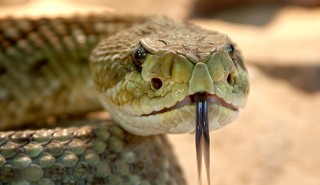Live snake-worship bite accident highlights need for change
24 November 2022

A 54-year-old man in rural Tamil Nadu, India, suffered a life-threatening snakebite at a local temple. Initial inappropriate first aid caused additional injury, making treatment by medics challenging, and highlighting the need for education and engagement with rural communities.
After a snake appeared in his dream and believing it to be a bad omen, a man consulted an astrologer. He was advised to perform live snake worship at a local temple that houses around 20 venomous snakes of various species, for this purpose.
On viewing the temple’s collection, the man identified the snake in his dream as a Russell’s Viper. It was recommended that he take part in the worship of this specific species.
The priest led the ceremony, instructing the man to kiss the snake on the head and mimic its tongue-flicking.
Lead researcher, Professor Sakthi Vaiyapuri said: “Getting this close to a highly venomous snake would be dangerous, even for an experienced handler using established techniques with hooks, gloves, and containers”.
“It is unsurprising that the man was injured but the priest’s response to the bite represents a worrying trend of dangerous and ineffective treatment of snakebites in the region.”
The movement of the man’s tongue and proximity to the snake’s head led to a strike from the snake, which bit and envenomated into his tongue. This immediately induced intense pain and swelling.
In an attempt to treat the bite, the priest took out his unsterile pen knife and made a deep cut into the man’s tongue. At this point, excessive bleeding became the more pressing medical issue and the man was transferred to a medical centre for treatment.
Because of the bleeding and swelling, it was very difficult to intubate the man, in an attempt to assist his breathing. Thankfully medics were eventually able to do so through his nose. They also administered an anti-venom and performed surgery to repair and restore the function of the man’s tongue.
Dr Senthilkumaran Subramaniam (the lead medic at Manian Medical Centre where the patient was treated) said: “This man is extremely lucky to be alive. His ongoing issues include problems with blood coagulation and raised levels of immune molecules, but he has survived and is able to speak and eat normally. It was an extremely difficult task to intubate him due to profuse bleeding and blood clots in the mouth”.
“We will use this case study as an example to teach rural communities about the dangers of snakebites, how to avoid them, and how to treat them effectively”.
“I want to ensure that these dangerous ceremonies are updated to prevent such injuries. And people need to know that cutting out the bite, along with other folk remedies, is not safe and shouldn’t be carried out. We also request the government to strictly ban the live snake workship in all religious and other relevant settings by enforcing the Wlidlife Protection Act.
“Even some of the emergency snakebite kits we see in this region are at best useless and at worst dangerous. So, education is paramount, right now.”
Professor Vaiyapuri and his team regularly spend time in rural communities in Tamil Nadu, carrying out highly effective engagement and education activities about snakebites. This will, in the long term, save lives and protect wildlife.

